| |
"Lake and Ladd had more in common than their series of films together – they were both golden-haired, both petite in stature, both attractive. Both were known better as movie stars than acclaimed thespians. Both struggled with alcohol, both experienced well-publicized ups and downs on and off screen, and in an odd and intriguing twist of fate, both died at the age of 50." |
| |
Karen Burroughs Hannsberry * |
As I mentioned at the start of my review of The Nice Guys, chemistry on screen can rarely be engineered. The bond that ignites something ineffable between two people is, put poetically, like magic. You know it when you're watching it. Alan Ladd and Veronica Lake had it and to use the noir vernacular, they had it in spades, or even Sam Spades. There's even an acknowledgement of their mutual attraction from their co-stars at the close of The Blue Dahlia. As the couple smoulder off screen, one of Ladd's war buddies suggests they wait for Ladd before they find a bar. "We gotta wait for Johnny?" his friend asks as he takes a look at the (presumably smooching) couple. "Whaddya think I am, a camel? C'mon!" The Blue Dahlia boasts a more streamlined and simpler plot than the earlier produced The Glass Key. Ladd plays a war veteran, Johnny Morrison, returning with two friends to California. One of the two, Buzz, belligerently played by Ladd's friend and sometime neighbour William Bendix, has shell shock. Coupled with his innate pugnacious character, his what we'd now call post-traumatic stress disorder drives him to rage faster than a bull clocking Superman from behind. The movie fizzes whenever he's on screen, his promise of violence at the drop of his or anyone else's hat seeming very real. While Johnny's buddies get an apartment, Johnny returns to his wife Helen (Doris Dowling) and quickly discovers two distasteful things. Firstly, she is having an affair with a nightclub owner, Eddie Harwood and secondly their child was killed while Johnny was away fighting in the Pacific because of her drunk driving and not from diphtheria as stated in a letter. Ladd is flint-eyed steel in his confrontations and his moral code seems to have no grey shades. Assuming Eddie is kissing his wife goodnight a little too enthusiastically, he just balls up his fists, strides over and socks him one. Noir inspired violence is very pleasingly direct. Pissed off and desolated by these revelations, Johnny wanders off in the rain to be picked up by Joyce (Lake) in a classic noir coupling. Has this mysterious blonde engineered this literal pick up or is fate steering them together? Johnny then has to go on the run and stay one step ahead of the police and the mob looking for him for the mysterious murder of his wife...
The film sits on the slender shoulders of its two leads, all four of which are up to the task. It's often been said and implied that both Ladd and Lake never knocked too hard on Brando's door when it came to challenge him at the thespian craft. But if you can stand still and look this good, the audience does most of the acting for you. What Ladd excels at is minimalist expression allowing the audience to deduce the buried twisted roots from the tiny twitching bud he allows us to see. In some ways, it's a master class of emoting on screen. The cliché of "less is more," is never more relevant to screen acting. Remember, both of these noirs were made when the evolution of television was just starting to reach a tipping point. From 1936 to 1948, ownership of televisions went from 200 homes to a million, the tiniest fraction of where we are now. The context these movies were designed for were enormous cinema screens. The tiniest facial tic in a close up could be termed as overdoing it. You could never charge Alan Ladd of being guilty of overdoing anything. Running parallel to the hunted husband story is the developing relationship between Johnny and Joyce. Lake as Joyce Harwood, the wife of the man having an affair with Ladd's wife (neat, huh?), is a silent partner, a bridging character in Ladd's attempts to clear his name and get at the truth. Each time they meet the embers stir and glow a little fiercer but this is no full on romance. The movie's action has a rare brutality to it in this world where men were men, women were dames and fists and bullets, the commas and full stops of sprocketed punctuation.
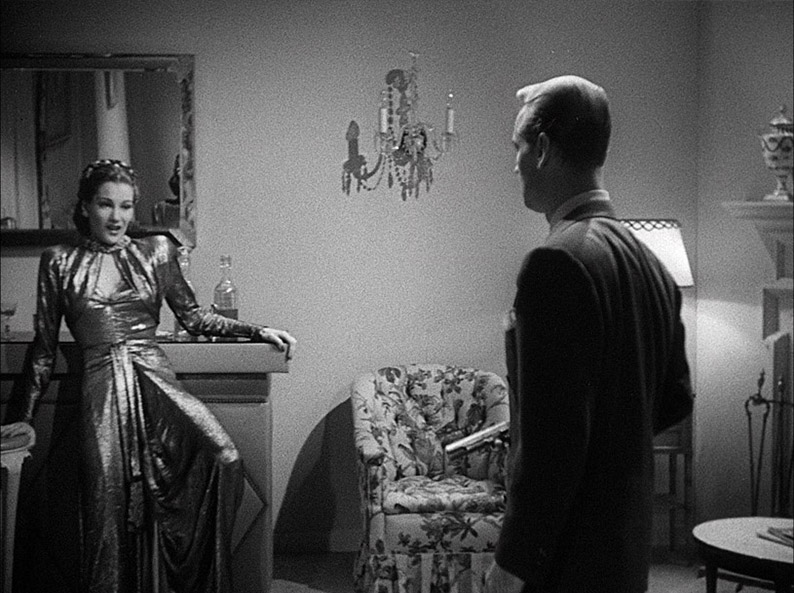
George Marshall's direction is unfussy and straightforward and the film has a narrative clarity to it, uncluttered and single-minded. There is an outrageously Freudian shot (and I have to give credit to the director for this, no other reading can possibly be made). At 15:52, Ladd's wife cowers up against a bar, legs slightly parted, the cut of the dress emphasizing her nethers as Ladd approaches with an unmistakably phallic .45 automatic. It's almost pornographic. Lionel Linden's crisp black and white photography ticks all the genre boxes with pools of isolated light, light streaming in through blinds and faces in shadow. Farciot Edouart's process photography (the back projected scenes playing behind the actors in a studio), though obvious by today's standards of compositing perfection, is pleasing to the eye, soft and distant but wholly in keeping with the atmosphere of the piece. Dahlia was the first produced original screenplay from the man many believe exemplifies noir in all of its moral ambivalence, the great Raymond Chandler. I cannot recall this particular writer without remembering his knock out line from his novel Farewell My Lovely... "Even on Central Avenue, not the quietest dressed street in the world, he looked about as inconspicuous as a tarantula on a slice of angel food cake." Curiously, if there is anyone easing up to Chandler as a competitor for the Noir Crown it has to be the author of the book upon which The Glass Key is based, Dashiell Hammett. Chandler was more famous as a writer whose novels have spawned classic films (Philip Marlowe was Chandler's creation, debuting in The Big Sleep in 1939). Given their authorial pedigree, both movies make a fine double bill hence the combined review.
The Glass Key's plot is a little more complex than Dahlia's. The title incidentally is referenced in the movie but it doesn't precisely explain its metaphorical reading. You can thank Extra contributor Alastair Phillips for that nugget. A glass key is an act or experience that cannot be reversed or forgotten. One suspects that the movie will be full of them. Temporarily going against Outsider's disdain for remakes, The Blue Dahlia proves itself a solid one on its own terms. The novel adaptation's first outing in 1935 starred George Raft and was directed by the Gilliam inspired name of Frank Tuttle (or is it Buttle?) I've not seen what we must call 'the original' so I'll let it gently go for the time being. Paul Madvig is a violent and corrupt political boss lending his influence to another more decent candidate for office, Ralph Henry. His motives are not exactly born from selfless altruism. Slapped by the beautiful Janet, Henry's daughter, the old rogue suddenly interprets this as perverse foreplay and promptly falls in love. His best friend and business partner Ed Beaumont is suspicious of the femme fatale thinking she's just humouring the thuggish Paul. It becomes apparent that she is disgusted by this man's stories of casual violence and forms an instant attraction to Ed. There's the Ladd/Lake dynamic working at full tilt, all veiled glances with hungry eyes. We've worked out that Ed feels the same way (or does he?) but is too attached to his partner to show any signs apart from thinly disguised disdain, something that seems to turn on Janet even more. The black sheep of the Henry clan is a son who's in deep with gambling debts, a potential embarrassment to Henry Senior's campaign for governorship. The son is also dating Paul's eighteen year old, Opal so there's a real linguine bowl of connections and swirling emotions and motivations in the mix. The incident that kick starts the violence and intrigue is Ed finding the son dead outside his father's house with his head caved in. The bond between Paul and Ed is strong but Ed begins to suspect Paul's involvement and moves in and out of favour trying to get at the truth.
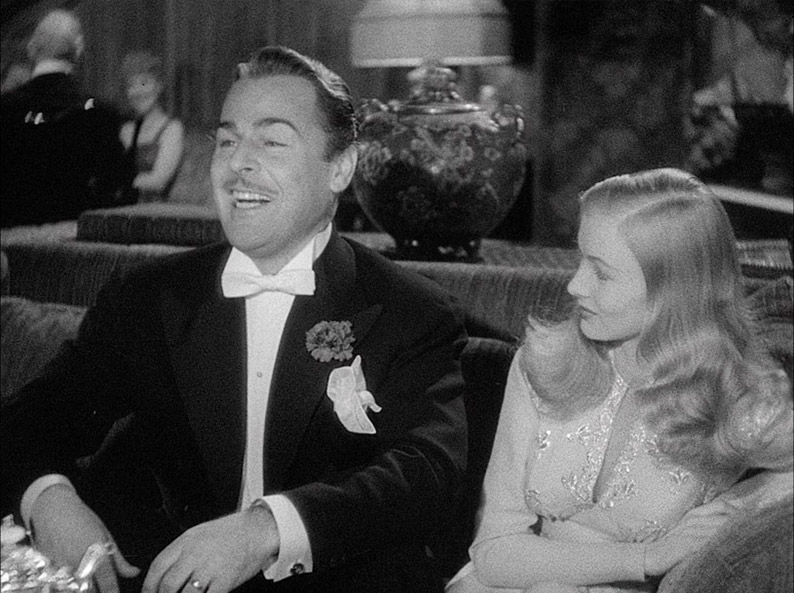
The real surprise and joy in this film for me wasn't the Ladd/Lake chemistry but seeing Brian Donlevy as Paul letting his hair down. The thug, made softer by his strong relationship with Ed, becomes a man of honour and integrity and it's a blast watching the normally dour and straight-backed Donlevy dive in and give it all he's got. He's playful at times. There's no question that the undercurrent of violence is always there but he does the right thing and makes the right decisions all the way down the line depending on Ed's love (can I say 'love'?) to redeem him in the eyes of the world. The last scene is a wonderful smack in the mouth to the cliché of two friends vying for the same woman. I finished the movie with a big Gruyère grin on my face. Despite falling out a few times during the running time, the bond between the two men is never broken and the relationship survives the torture and violence everyone is throwing their way. In some sense, it's like seeing the impassive and decidedly stiff Arnold Schwarzenegger suddenly exhibit a sense of humour. Donlevy hasn't cropped up on my radar too often (interesting that he was the star of the last but one film I reviewed, Hangmen Also Die) but his performance in The Glass Key is a real delight.
In the middle of the film, Ed undergoes a tortuous beating by his real life friend and co-star from Dahlia, William Bendix as Jeff, a hired thug. There's a story that the two men formed a friendship after Bendix was distraught with anguish having knocked Ladd out for real. His sincere apologies bonded the men and I don't know why but I love stories like that. But the scene of his beating is one of the nastiest I've ever seen in a noir. You feel every thump. Bogart usually has to deliver one punch and rarely gets worked over a tenth as much as Ladd suffers from Bendix's relentless fists. Ladd looks really hurt too, the make up surprisingly convincing. If the beating is brutal, you should see the escape. The extraordinary power of his plan to keep the bad guys busy while he finds a way out is so unexpectedly visceral you're wincing as his body falls through glass and smashes into a table. It's the one scene in the film I really sucked teeth at. Bravo to the stunt man or men for the two shots of falling. It's utterly and shockingly credible.
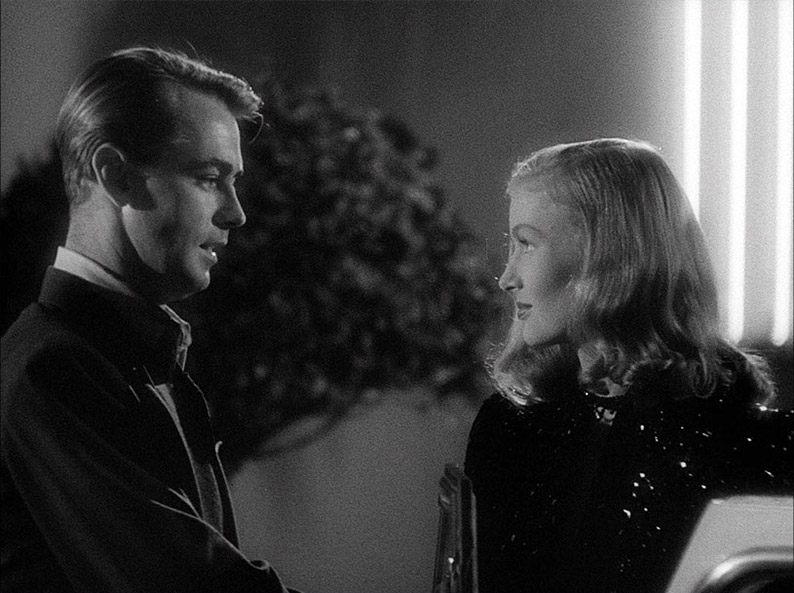
Both The Blue Dahlia and The Glass Key are terrific examples of noir and show Alan Ladd for the rather talented actor he was. It's a quirk of historical fate that he's not as well known now or as iconic as Humphrey Bogart. But if Ladd's legacy has some echoes and relevance to the present day, it's the result of his son's tenacity against all the odds in supporting a filmmaker while the studio he worked for was keen to shut his production down. This troubled film was called (come on, you know this right?) Star Wars and Ladd Jnr. was its champion and subsequently spectacularly vindicated. If that's not enough for the history books, his company was behind Blade Runner and a film close to my heart for personal reasons, the masterful The Right Stuff. Currently bathing in the cash cascade that is Star Wars et al, Disney has a lot to thank Alan Ladd Jnr. for.
Both noirs are presented in the 1.37:1 aspect ratio but unlike the earlier reviewed Hangmen Also Die, the two movies feature visible grain that the screen shots may illustrate. On conventional HD TVs, it's less noticeable but on high resolution computer monitors it's quite obvious. Again, there's no real distraction to the viewing pleasure but the difference between the two noirs and Hangmen is marked. Increased grain points to copy deterioration and if I had the scanning notes from the booklet I may be able to confirm this but it looks like the materials scanned were inter-positives or dupe negatives. Of course the original film stock, the negative may have just been less advanced but a comparison on the years of production don't bear this out at all... The Glass Key (1942), Hangmen (1943) and Dahlia (1946). No matter. The contrast ratio is also not as pronounced as in Hangmen but these are quibbles and these two discs probably provide the best quality that these films have enjoyed domestically in a long while.
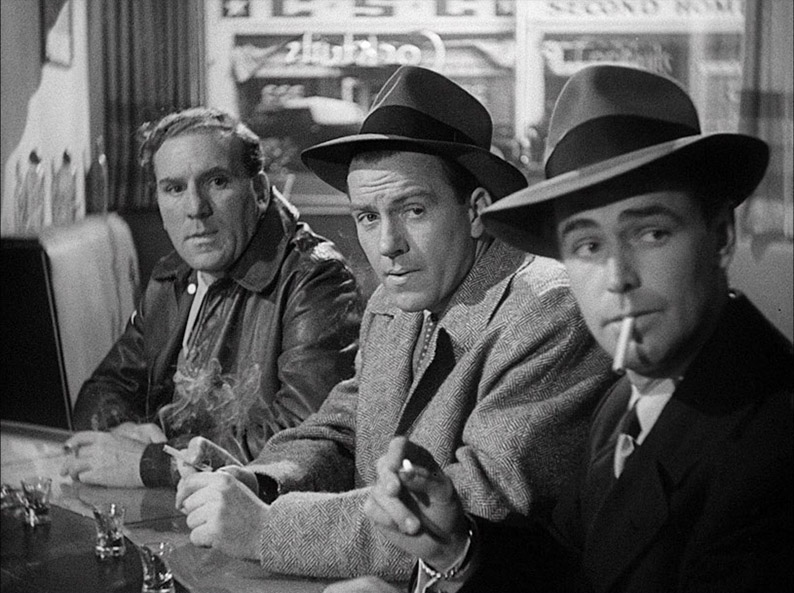
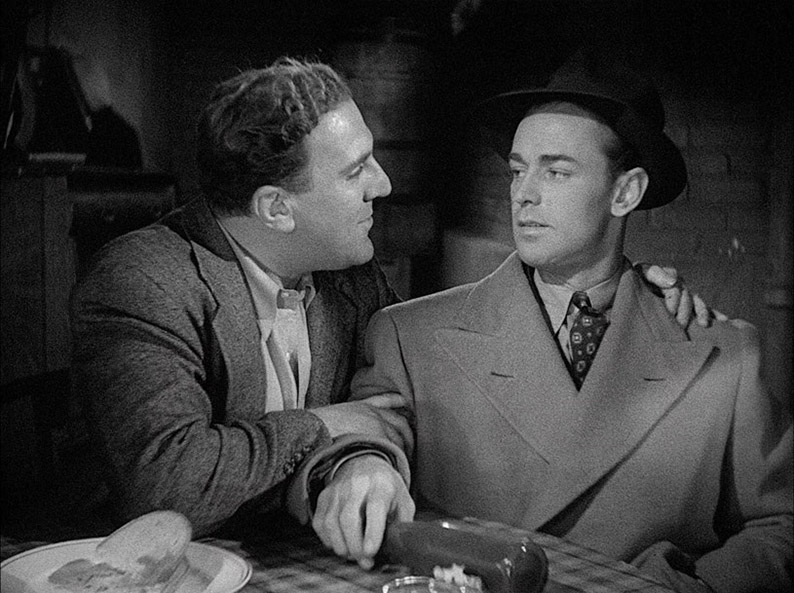
There's nothing wrong with the original mono soundtracks at all, again, all dialogue perfectly understandable. Particular attention has been paid to the sound effects of the violence and the glass breaking, all damn dramatic and very effective.
| special features – The Blue Dahlia |
|
Selected scene commentary by Frank Krutnik, author of 'In a Lonely Street: Film Noir, Genre, and Masculinity'
The two scenes featured for commentary duties are the opening and the party scene both of which play as a standalone Extra (meaning that the whole movie doesn't play as in normal commentaries). Krutnik is very fond of digging deep for meanings in what could be seen as a fairly shallow surface subject. But then I don't write noir books so he's infinitely more qualified than me to wallow in sub-text. Where I see three guys getting off a bus, veterans from a war still being fought, Krutnik reminds us that the forces' life could be interpreted as a homosocial arena. I'm pretty sure he said 'homosocial' and while I could take a guess at its meaning, it's not a word I've ever heard before. OK... Now they are back in the heterosexual world and having to deal with women, something that hasn't bothered them while forming intimate bonds with their fellow soldiers at a time of war. Yeah, OK. He notes that from one small look after his friends mention Ladd's wife, Ladd communicates "...a wealth of unspoken detail." Damn right. Krutnik also remarks upon the rather unsympathetic, one note character of Johnny's less than upright wife Helen played by Doris Dowling. It's a part designed for us not to care too much when we find out she's been murdered. Krutnik also highlights the Freudian interpretation that can be laid at that one particular shot mentioned earlier. Given the detail Krutnik goes into, I was a little disappointed the commentary didn't cover the whole movie. But then his 'introduction' covers a lot more ground – see later.
Extensive gallery of vintage stills and promotional materials
This is a very capricious use of the word 'extensive'. In other contexts you may have an extensive number of eggs in a box or be caned in school by having an extensive number "...of the best." If you hit the cricket ball and it sails over the boundary, you get an extensive number of runs. I could go on but I think you get the point. Unless I was not using my remote properly, there are five publicity stills and a poster. Six. Just six. Extensive.
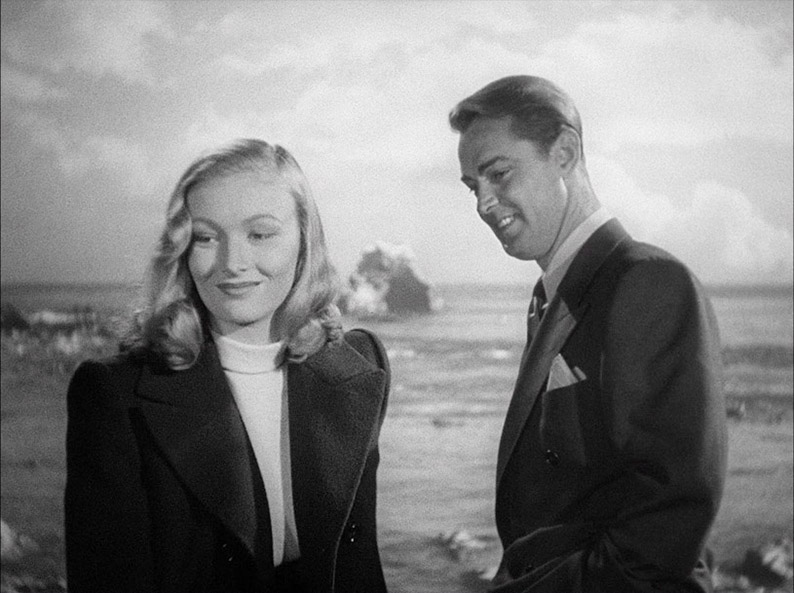
Introduction to the film by Frank Krutnik (29' 22")
I'm assuming this is the 'Small Boy, Tough Guy' extra. Sitting on a sofa bedecked with an extensive number of pillows, Krutnik struts his noir credentials and he's an easy and well informed guide to the genre and in particular Alan Ladd. He covers some stories about the film's production, stories I was very tempted to mention in the review. They are well told and may come as a surprise to some not versed in the political machinations of Hollywood. Let's just say that Chandler intended the killer to be... Oops. Let's just say that Chandler's aim was to highlight the psychological instability of returning war veterans. Did I get away with that? Well, William Bendix did. Krutnik also makes a few points I've mentioned in the review. Not guilty as ever. Just a normal coincidence. It's a solid Extra talking head with clips and stills interspersed.
Rare 1949 half-hour radio dramatization of 'The Blue Dahlia' by The Screen Guild Theater, starring Veronica Lake and Alan Ladd (28' 56")
In comparison to The Glass Key's similar Extra (see later), this recording really shows its age. It sounds like it's been recorded in cotton wool. I'm not complaining but you really need to listen hard to make sense of it. The Camel cigarette advertising is a blast, similar to that featured on the Letters To Three Wives disc. Studio publicity shots give you a visual accompaniment but it really is a tough listen so for completists only.
Original theatrical trailer (2' 30")
"Ladd", "Lake", "Bendix"! A thrilling threesome to be sure. God I love old trailers. It's a little soft but still riveting stuff. The voiceover is over the top, gloriously so but the clips are well chosen and nicely put together. There's even the Freudian shot. "The big three make "sock" entertainment," is my favourite title pronouncement. I mean what the hell does it mean? Muppets?
Reversible sleeve featuring original and newly commissioned artwork by Tonci Zonjic
This wasn't available for review but the artwork is visible on line and looks terrific.
| special features: The Glass Key |
|
Audio commentary by crime fiction and film expert Barry Forshaw
"Welcome to the audio commentary..." says Barry. We get a warning that he will not be covering the film with scene specific commentary. Fair enough. The man knows his onions. One of the points he makes references (naturally) Albert Camus' L'Étranger, one of the best examples of presenting characters whose motivations are not clear cut so that the readers or audience are invited to figure our the character's drives for themselves. He notes that there is a homoerotic connection between Ed and Paul, best buddies but what happens in the film that allows anyone to jump to that conclusion and what exactly is a 'homoerotic connection'? A gay extension lead? Is he implying that Ed and Paul are physically attracted to each other? I don't see that at all. Must look into it. Nobody, myself included I see, seems to write about Alan Ladd without mentioning his lack of height. I don't get it. Loads of movie stars are short and at 5' 5" or 6", he's hardly a hobbit. Chandler's own quote about Ladd didn't just come back to haunt him but came back to torture the poor guy. And the quote didn't even reference his height though you may be forgiven for believing it did. Chandler called Alan Ladd a "small boy's idea of a tough guy". I don't see too much wrong with that. I was determined in these reviews not to make a big deal or even mention Ladd's height or lack thereof but it's like writing about George Lucas and not mentioning Star Wars. How often do you see Lucas' name on movie posters followed by "From the man who brought you Howard the Duck..."?
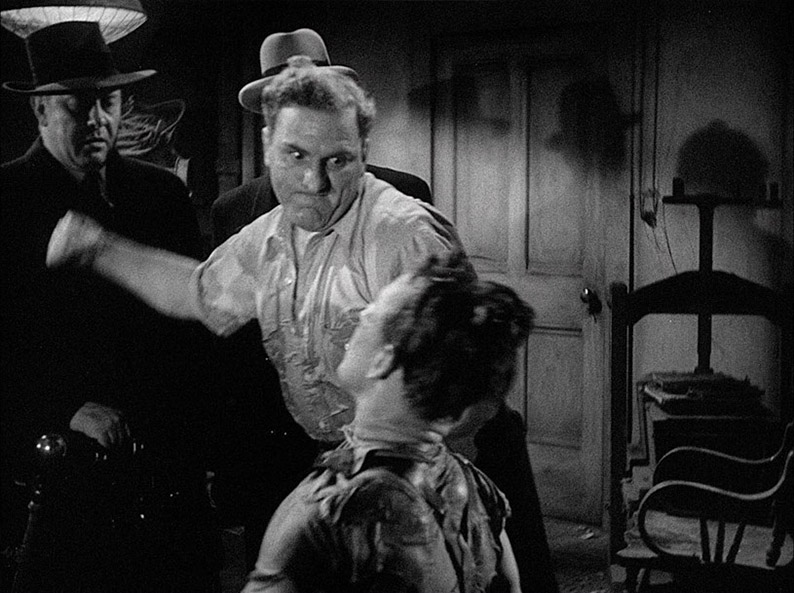
Forshaw references other famous movies that have featured the swinging light bulb as an effect. Here it's Bendix taking a back swing for another gut punch. He reminds us that Clint Eastwood had Sergio Leone tear up pages and pages of dialogue because like Ladd, Eastwood could 'say' the words with just a look. He tells us of Brian Donlevy's morning ritual... Dentures, hairpiece, corset, elevator shoes. Wow, now there's a transformation. You wonder what he really looked like. Not being able to keep the homoeroticism down, Forshaw mentions that in the first remake of Ben-Hur, Stephen Boyd as Messala was directed to believe that he desired a homosexual relationship with Ben-Hur. Needless to say William Wyler didn't tell Charlton Heston. And again with the boy on boy action. William Bendix is very physical with Alan Ladd but he's playing drunk. Does Mr. Forshaw mean to suggest that when inebriated and overly tactile, men are revealing hidden desires? But all told, this is a hugely informative commentary and well worth an outing. Outing... Is that my latent homoeroticism talking? Down boy.
'Comings and Goings', A new visual essay on the film by Alastair Phillips, co-author of '100 Film Noirs' (23' 27")
This academic reading of the film is informative and if you're not attuned to the finer detail of cinema studies, it may strike you as a little odd. Phillips has boiled The Glass Key down to a movie in which characters, specifically Ladd's Ed Beaumont, enter a room via one door and then exit from another. Yes, apparently, it's a valid reading and I sat there somewhat bemused by this observation. Isn't this aspect of mise-en-scène relevant to most films? I loved hearing that the cameraman's name was Sparkuhl. That's like having a plumber called Mr. Leak. There is some T.S. Eliot influence in the movie but buried so deep it's not worth settling on. There are the sexual aspects that readings of movies like this engender. Really? There's sexual tension that releases itself through violence particularly broken glass. Why is it sexual tension? Can't it be, uh, I don't know... tension? And again, there are the implicit homosexual tensions – not to me but again, hey. There is a surfeit of 'Uh's as Phillips' effort has been presented, one assumes, virtually uncut. A little judicious editing may have been wise here. But odd analyses apart, this is a good Extra.
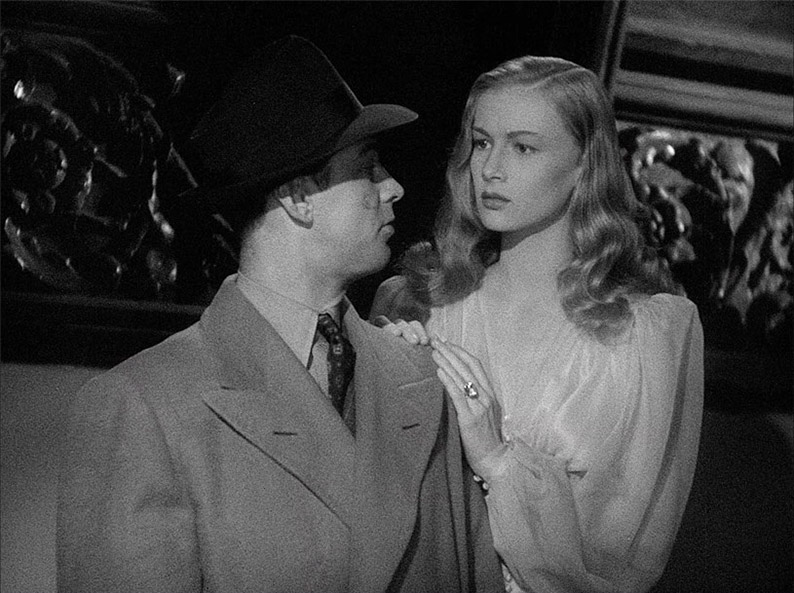
Rare 1946 half-hour radio dramatization of 'The Glass Key' by The Screen Guild Theater, starring Alan Ladd, Marjorie Reynolds and Gene Kelly(29' 37")
Despite the listing in the publicity materials, Gene Kelly is nowhere to be heard. I can't imagine Kelly playing any of the thugs but he has a pleasing if soft voice but you won't hear it here. Also absent is Brian Donlevy as the thuggish Paul. But taking his role is the inimitable Ward Bond, one of John Ford's regular players. Ladd is essentially the narrator as Ed steering his way through a murder questioning his friendship and falling in love... We take a break after the first act for the commercials... Lady Esther advertising skin cream – hilarious. Four Purpose Face Cream "...just smoothed on gently!" What absolute, unscientific bollocks. I loved it. And the bloody product is still on sale today. Amazing. The radio version is short but it still works as a murder mystery. In fact minus the commercial and the end announcement, the actual radio presentation is only about 22 minutes long. There's also a little frisson at the end as the announcer names all features on the 'coming soon' roster of movies. Was there ever a time when It's A Wonderful Life was coming soon? Hasn't it been with us forever?
Original theatrical trailer(1' 37")
"What a sock!" it says as its opening caption. OK, so a sock is a punch. I get it. Not a muppet. This trailer, rather disappointingly gives away the two shots I was so surprised by but then a trailer needs to sell a movie and this one does quite dramatically. Also it's not in too bad a state.
Extensive gallery of vintage stills and promotional materials
Almost doubling the extensive six of Dahlia, here we have eleven stills with some in colour. It's still not up there with my dictionary definition of the word ("large in amount or scale") but hey, it's a good feature to make a modern audience understand what passed for a studio portrait in the 40s.
Reversible sleeve featuring original and newly commissioned artwork by Tonci Zonjic
This wasn't available for review but the artwork is visible on line and looks terrific. Hey, déja-écrit...
Noir fans will drool over these two wonderful examples of the genre. Both discs are top notch with the actual films a little grainier than the best examples of old movie restoration but Ladd and Lake sizzle and the plots satisfy and if you're new to noir, the work of Raymond Chandler and Dashiell Hammett is a great place to start. Well recommended.
*https://shadowsandsatin.wordpress.com/2013/07/12/the-dynamic-duos-blogathon-alan-ladd-and-veronica-lake/
|